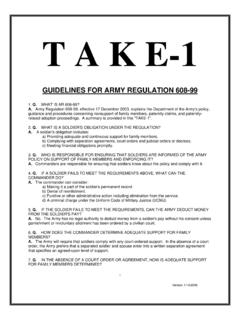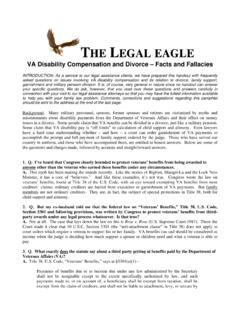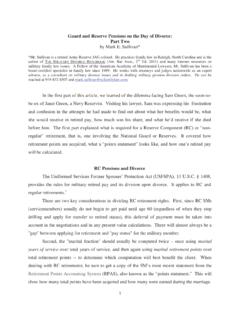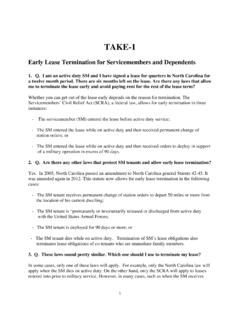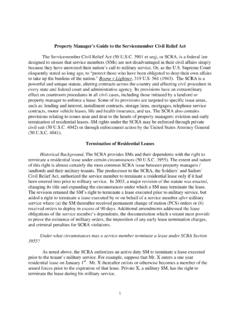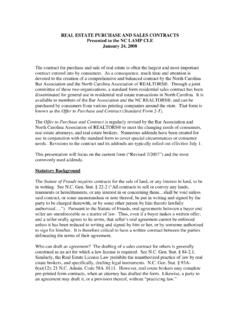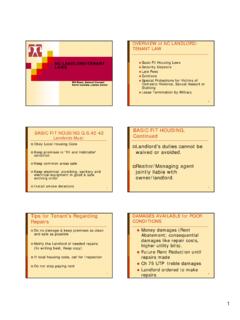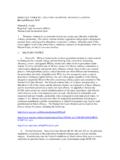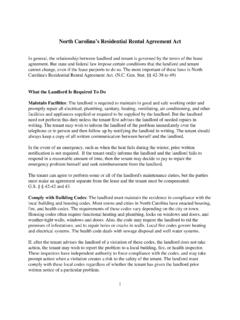Transcription of Domestic Violence Military Response and …
1 1 Domestic Violence ; Military Response AND regulations Revised February 2010 Michael S. Archer Regional Legal Assistance Officer Marine Corps Installations East 1. Domestic Violence is an important issue in our society and, likewise, within the Military community. This article explains Military regulations and programs designed to prevent, limit, and respond to allegations of Domestic Violence . Although much of this article applies to all of the armed forces, emphasis is placed on the procedures within the Marine Corps, of which I am most familiar. 2. Military JUSTICE. a. Generally. Military Justice refers to those procedures relating to courts-martial, including pretrial restraint, charge, pretrial hearing, trial, conviction, sentencing, clemency, review, and appeal. Military Justice also refers to those procedures under Article 15 of the Uniform Code of Military Justice (UCMJ) by which a commander is authorized to adjudicate and punish minor offenses without resort to the court-martial process.
2 Although Military justice related decisions are often difficult and momentous, the procedures are fairly straightforward. With very few exceptions; such as special procedures relating to capital offenses, the same rules apply regardless of the offense charged or suspected. Most of the rules concerning Military justice are contained in The Manual for Courts-Martial. The Manual contains rules of evidence and procedure, a definition of all of the crimes and the elements thereof, an explanation of these offenses, and the maximum authorized sentence for each offense. Its appendices include the UCMJ, and a section by section detailed analysis of the rules, procedures, and offenses, with reference to the most important cases on each. The Manual is remarkably well organized and user friendly, particularly when compared to most state penal codes.
3 At chapter V, the Manual also provides rules for nonjudicial punishment, including the maximum punishments and the circumstances in which Commanders may impose such punishment for minor offenses. The Manual for Courts-Martial can be found on line from a variety of sources, including the following: b. Pretrial Restraint. Rules for Court Martial (RCM) 304 and 305 are the principal regulations concerning in the imposition of pretrial restraint upon a service member suspect. Restraint may take the form of conditions on liberty (most often used overseas), restriction to specified limits, or confinement in jail. Confinement under RCM 304 2contemplates the prosecution of the suspected offender by court-martial. After all, it is called pretrial restraint. Accordingly, the person initially ordering the confinement and the Commander reviewing such confinement must have probable cause to believe that the person to be restrained committed an offense triable by court-martial.
4 Although not a particularly career enhancing move, the most junior lieutenant may therefore order the Sergeant Major of the Marine Corps to be restrained. Only the Commanding Officer can order pretrial restraint upon an officer. c. Pretrial Confinement. (1) Imposition of Pretrial Confinement. As with other forms of restraint, pretrial confinement may be imposed by any officer upon any enlisted person. Pretrial confinement may be imposed upon officers only by the commanding officer. In accordance with RCM 305, pretrial confinement requires (1) probable cause that an offense triable by court-martial was committed by the suspect, (2) that it is foreseeable that the accused will either commit serious misconduct if not confined or will fail to show up for trial, and (3) that lesser forms of restraint are inadequate.
5 Military regulations make no provision for the posting of a bail bond. (2) Review of Pretrial Confinement. Within 48 hours, the Commanding Officer is required to review the adequacy of pretrial confinement. As a practical matter, such review has already taken place, as the Commanding officer himself is generally the person who orders the initial imposition of pretrial confinement. Within 72 hours, the Commander is required to produce a written decision memorandum setting forth the reasons for pretrial confinement. Within seven days of the imposition of pretrial confinement, a hearing will be conducted before a neutral and detached magistrate who will examine the lawfulness of the pretrial confinement. For good cause, the hearing may be extended such that it occurs no more than ten days from the imposition of pretrial confinement.
6 Though the accused has the right to free Military counsel at the hearing, it is a fairly informal affair in which the rules of evidence do not apply. Upon request, the magistrate conducting the hearing may reconsider his earlier decision if presented with significant information not previously considered. After the charges have been referred for trial, the accused may also request that the Military judge examine both the imposition of pretrial confinement and its nature. Improper pretrial confinement, or unduly harsh conditions of pretrial confinement may result in the judge directing credit against the accused s sentence over and above the day for day credit to which the accused is already entitled. (3) Relationship to Speedy Trial. Per RCM 707, the accused must be brought to trial within 120 days after the preferral of charges or the imposition of pretrial restraint, whichever comes first.
7 Delays caused by the accused are not counted against the government. The remedy for the denial of a speedy trial is invariably the dismissal of the charge. Thus, speedy trial issues present yet another reason for a commander not to undertake pretrial restraint lightly or prematurely; it begins the speedy trial clock. Note that 120 days is the outer limit of delay; a judge may determine that the accused has been denied a speedy trial prior to the 120 day mark. The government must proceed with 3 reasonable diligence in its progress towards trial to avoid a violation of the speedy trail requirement imposed by UCMJ Article 10. v Kossman 38 MJ 258 (CMA 1993). 3. Military PROTECTIVE ORDERS a. Generally. As seen above, a Commander can direct pretrial restraint or even pretrial confinement, but his ability to do so is circumscribed.
8 The Commander must contemplate trial by court-martial and he must have the requisite probable cause. In a word, in order to direct restraint pursuant to the Military justice model, the Commander must conclude that the accused has committed a crime warranting such restraint. Furthermore, the decision to impose restraint will be reviewed quickly, first by a magistrate and then, at the accused s request, by a judge. Finally, pretrial restraint triggers the speedy trial clock. Accordingly, the imposition of pretrial restrain may not the preferred tool in a variety of cases: when the facts are unclear, where some form of sanction other than court-martial is contemplated, or where the facts have not yet been investigated sufficiently such that trial may begin in the near term. The Commander may choose to protect good order and discipline by using a different tool, the Military Portective Order (MPO).
9 Such an order directs the service member to stay away from a particular person and / or a particular place. There are no hearing requirements, and there is no requirement to find fault. For example, if the Commander receives information indicating that an active duty Marine and his civilian spouse have had a violent altercation, he may direct the Marine to stay away from his regardless of whether he believes the Marine committed an offense. Per Department of Defense Instruction (DoDI) , Commanders may issue an MPO regardless of whether a Civilian Protection Order (CPO) has been issued. Such MPOs can be more restrictive than the CPO, but can not otherwise contradict the CPO. b. Procedure. The Commander may issue an MPO upon hearing of facts that, in his opinion, warrant its issuance. The information may come in any form, and need not be in writing, so long as it is sufficient to convince the Commander that an MPO is appropriate.
10 The MPO may be issued at the request of one of the battling spouses or without a request. It may even be issued, or kept in force, despite the express request of the parties for its removal. There is no requirement that the MPO be in writing, though for practical reasons, it almost always is. The lack of procedures makes the MPO a very quick and important tool in preventing further instances of Domestic Violence . Victim advocates at installation community counseling centers can assist victims to obtain an MPO. Military directives caution Commanders to ensure that the MPO is tailored to the circumstances. For example, the Commander may fashion the order in such a way that the service member, without endangering the spouse, can obtain Military uniforms and other necessities from his house and visit his children.
